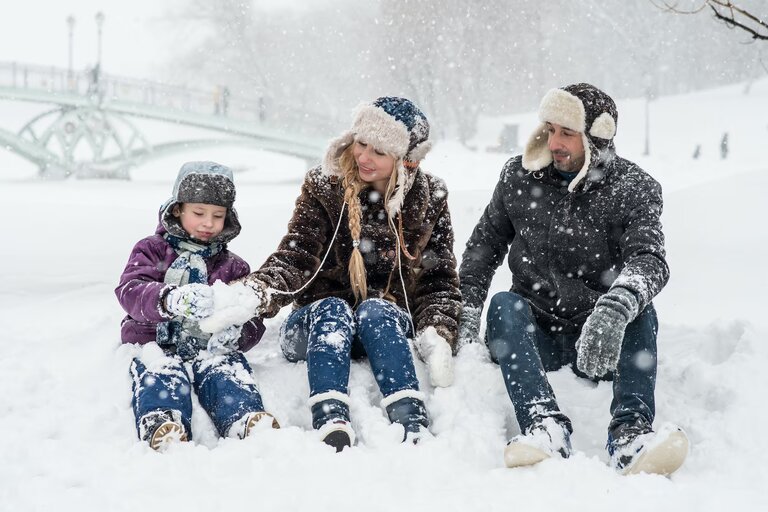Winter can transform the outdoors into a beautiful wonderland, but it also brings unique challenges and risks. From icy sidewalks to heavy snowfalls, staying safe during the colder months requires preparation and caution. Here are eight essential snow safety tips to help you and your family navigate the winter season safely.
Top 9 Snow Safety Tips for the Winter Season:
1.Dress for the Weather:
Dressing in layers is integral to staying warm and comfortable in cold winter weather, especially if you’re spending time outdoors in the snow. While it is important to dress to prevent cold-related emergencies, like hypothermia and frostbite, outdoor activities can raise your own body heat, making bulky winter clothing uncomfortable. By dressing in layers, you can easily adjust your clothing to match the intensity of your activity level and the temperature of your environment. This can help you maintain a comfortable body temperature and prevent you from getting too hot or too cold.
Start with a base layer made of moisture-wicking material, such as synthetic fabrics or merino wool. Moisture-wicking materials are designed to keep you warm and dry. Next, add an insulating layer. This layer should be made of a material that traps air and helps retain heat, such as fleece. Finally, finish with an outer layer. This layer should be wind and water-resistant to protect you from the elements.
2.Prepare Your Vehicle:
Driving in snowy conditions requires a well-prepared vehicle. Ensure your car is equipped with snow tires or chains for better traction. Keep an emergency kit in your vehicle with essentials like a flashlight, blankets, water, snacks, and a first-aid kit. Before heading out, clear all snow and ice from your car to improve visibility and prevent hazards to other drivers.
3.Wear Proper Snow Gear:
In addition to dressing in layers, accessories are equally crucial for staying safe in the cold. Be sure to wear a hat, scarf, and gloves or mittens to keep your extremities warm. Wear waterproof and insulated boots that provide traction for walking on slippery surfaces and thick socks to keep your feet warm. You may also want to use hand or foot warmers to stay extra cozy.
4.Shovel Smartly:
Shoveling snow can be strenuous, especially for those unaccustomed to heavy physical activity. Use a lightweight, ergonomic shovel to reduce strain. Take frequent breaks, and push snow rather than lifting it whenever possible. Wear sturdy footwear to avoid slipping, and stretch beforehand to prevent injuries.
5.Practice Proper Snow Shoveling Techniques:
Approximately 11,500 ED visits are attributed to snow shoveling-related accidents each year, thus it is imperative to utilize safe shoveling practices to prevent any potential harm. Use a lightweight, ergonomic shovel to ease the pressure on your body and start with a gentle warm-up. When pushing or lifting a shovel in the snow, maintain your back straight and bend at the knees rather than the waist. Throughout your shoveling exercise, take periodic rests to ensure your muscles are properly rested.
6.Prevent Slips and Falls:
Slippery ice and snow-covered surfaces increase the risk of slips and falls during winter. To prevent accidents, walk carefully on slippery surfaces, using handrails whenever possible. Take small steps and consider using slip-resistant footwear or adding ice cleats for extra traction. Don’t forget to clear your driveways and sidewalks of snow and ice to create a safe pathway for others.
7.Keep an Eye on the Weather Forecast:
Weather conditions can change quickly during the winter season, so keeping an eye on the forecast is essential for staying safe. Be sure to check your local weather report frequently and pay close attention to any warnings about hazardous conditions such as snow storms or extremely cold temperatures. Getting into the habit of creating a winter weather plan can help you know what to do in an emergency.
8.Practice Safe Winter Driving:
Driving in the winter calls for extra caution, particularly during the hectic Christmas season. Verify your car’s condition, especially the tread and tire pressure, before you get on the road. Keep a safe distance from other cars and drive carefully. To prevent skidding, accelerate and decelerate gradually. In case of an emergency, keep a winter emergency kit in your car that includes supplies like a shovel, blankets, snacks, and a flashlight.
9.Take Precautions During Winter Sports:
Winter sports enthusiasts need to take precautions to ensure their safety. Wear appropriate protective gear, such as helmets and padding, for activities like skiing, snowboarding, or ice skating. Always follow designated trails and slopes, and warm up before engaging in physical activities to prevent muscle strain or injury.
By following these winter safety tips, you can embrace the season with confidence, knowing you have taken necessary precautions to stay safe and well-prepared.




